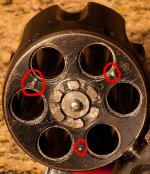This no dash 6" model 28 I recently bought is turning into a real headache.
First and foremost, the cylinder will not open reliably. And in fact, by opening it, it appears something is rubbing on it and catching on the cylinders, causing a serious rub mark on the rear faces of the recessed cylinders.
This and a "gritty" action led me to completely tear down the gun and clean it. (everything except remove the extractor rod from the cylinder).
Took everything apart, this is the most filthy gun I have ever seen in my life. Literally sand in there. I had to clean every part, Q-tip the hell out of every hole and crevice including firing pin hole, hand hole, and the ejector lock hole (or whatever it's called). This is a 4 screw model, so it had the cylinder stop pin/spring hole (I like this much better than the newer ones).
At any rate, put everything back together and it still does the same thing, although action is much better. The cylinder failing to open is a real show stopper. I dont want to cause permanent damage to it if it's not already happened.
Also, the trigger in single action seems to be flawed. When cocking the hammer for single action, the trigger seems to come too far back, it's literally ALL the way back to the frame/grip. You literally breathe on the trigger and it releases. There is no trigger stop or cutout for one. Again, this is not right.
I think I now know why this was priced so low.
First and foremost, the cylinder will not open reliably. And in fact, by opening it, it appears something is rubbing on it and catching on the cylinders, causing a serious rub mark on the rear faces of the recessed cylinders.
This and a "gritty" action led me to completely tear down the gun and clean it. (everything except remove the extractor rod from the cylinder).
Took everything apart, this is the most filthy gun I have ever seen in my life. Literally sand in there. I had to clean every part, Q-tip the hell out of every hole and crevice including firing pin hole, hand hole, and the ejector lock hole (or whatever it's called). This is a 4 screw model, so it had the cylinder stop pin/spring hole (I like this much better than the newer ones).
At any rate, put everything back together and it still does the same thing, although action is much better. The cylinder failing to open is a real show stopper. I dont want to cause permanent damage to it if it's not already happened.
Also, the trigger in single action seems to be flawed. When cocking the hammer for single action, the trigger seems to come too far back, it's literally ALL the way back to the frame/grip. You literally breathe on the trigger and it releases. There is no trigger stop or cutout for one. Again, this is not right.
I think I now know why this was priced so low.



